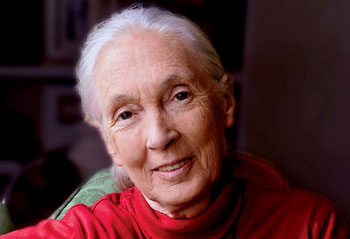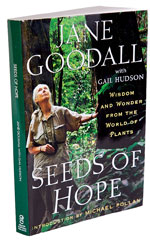sierraclub.org - sierra magazine - may/june 2013 - trendsetter: jane goodall
Schmear Campaign | Trendsetter: Jane Goodall | Ecofriendly Cellphone Accessories
 Jane Goodall, primatologist and conservationist
Jane Goodall, primatologist and conservationist
Photo by Stuart Clarke
TRENDSETTER: JANE GOODALL
Jane Goodall may be the world's most famous primatologist—50 years ago, she became the first to prove that nonhuman animals make tools—but lately she's been spending more time focusing on a life form much less intelligent than the chimpanzees she studied in Tanzania's Gombe Stream National Park. In fact, one that has no brain at all: plants.
Her newest book, Seeds of Hope: Wisdom and Wonder From the World of Plants (Grand Central Publishing, April 2013), cowritten with Gayle Hudson, chronicles her lifelong love of all things leafy. In it, she writes, "There would be no chimpanzees without plants—nor human beings either" and confesses that she might never have started studying apes had she not, as a child, been obsessed with Africa's forests.
Goodall, 79, runs the Jane Goodall Institute, which protects chimpanzees' habitat, and Roots and Shoots, which encourages children to become conservationists. She's also a U.N. Messenger of Peace and a Dame of the British Empire. We spoke to her to find out what compelled her to spend years writing a book about the botanical world.
Q: You're best known for your work with animals. Why the newer focus on plants?
A: It was as though the plants put little roots into my brain. They said, "Look, Jane, you've spent all your life doing stuff for animals. It's our turn now." So it ended up being this incredibly inclusive book, which led me into very dark areas, into the plantations and the slave trade, all the horrors of modern agriculture with its chemical pesticides and fertilizers, and then—what I'd just planned to mention but what ended up turning into a huge chapter—genetically modified plants. That was the most chilling of all.
"It was as though the plants put little roots into my brain. They said, 'Look, Jane, you've spent all your life doing stuff for animals.
It's our turn now.'"
—Jane Goodall
Q: Why was that so chilling?
A:I can best answer that by telling you about another new book. Steven Drucker's Altered Genes, Twisted Truth is the most chilling thing I've ever read. It's about the huge conspiracy by the big companies who do genetic modification to keep the public from knowing the truth, to subvert the course of justice. I didn't realize that when you put genes into a plant, you have to shoot them in, and the plant fights every bit it can to keep those alien genes out. So they have to shoot them in like miniature cannons.
Q:
What other surprising things did you learn?
A: I found some utterly fascinating stories. An Israeli botanist heard about archaeologists who had discovered ancient date-palm seeds while they were excavating King Herod's mountain fortress outside Jerusalem. Though they were reluctant to share anything, she persuaded them to give her three of those seeds. Two were damaged by carbon dating—they were 2,000 years old—but the third one grew. And that tree, known as Methuselah, is now fully grown. And then there's an even more extraordinary story: Scientists who were drilling into Siberia's permafrost found some material from the nest of a prehistoric ground squirrel. And in that material, they discovered three living cells. From those cells, they were able to re-create the plant, which was a meadowsweet. Not only did it grow from those cells, but it's reproducing and making seeds. And it's 32,000 years old.

Q:
Wow.
A: And there are stories about plants that remove nuclear materials from soil.
Q:
Which plant does that?
A: Hemp. It's actually the most magical and amazing plant. It's ridiculous to ban people from using it. It has nothing to do with marijuana at all. And it can remove nuclear waste from soil. You just grow it, and then you cut the poor thing; it's done its work.
Q:
What inspires you to keep doing the work you do?
A: I care about the planet. I care about the future. I care about my grandchildren. And I feel a deep anger about what we've done to the planet since I was the age of my youngest grandchild.
Q: What do you tell children who show an interest in becoming a naturalist?
A: I tell them that I loved animals and nature when I was a child and that I was told there was no future in that for me. But if you're passionate about it, something's going to happen. Even if you don't get a job that's to do with nature per se, you still can enrich your life hugely by bothering about plants. You can have them growing in your windowsill. You can look for them as you walk around. You look down at the pavement and see what's pushing up through it.
Q: I can probably guess the answer, but what's your favorite place on Earth?
A: Well, you think I'm going to say Gombe, and in a way it is. But it's so different from the Gombe that I loved when I first went there, which was wild. It was just the forest and the chimps and me. Now there are tourists and rules, and the forests around the park have been cut down. Gombe is not the place it was. So I love coming back to England because it's where I grew up. The same trees are there, the same garden, the same beech tree up which I spent hours, the same cliffs, the same sea where I used to wander as a child.
—interview by Avital Andrews
• Maggie Q
• Olympic swimmer Natalie Coughlin
• Olympic snowboarder Hannah Teter
• Vegan ultramarathoner Scott Jurek
• NFL player Ovie Mughelli
NEXT: Ecofriendly Cellphone Accessories
Seeds of Hope photo by Lori Eanes